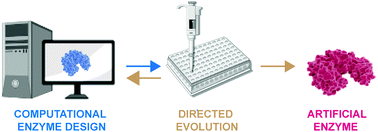Artificial enzymes bringing together computational design and directed evolution
Abstract
Enzymes are proteins that catalyse chemical reactions and, as such, have been widely used to facilitate a variety of natural and industrial processes, dating back to ancient times. In fact, the global enzymes market is projected to reach $10.5 billion in 2024. The development of computational and DNA editing tools boosted the creation of artificial enzymes (de novo enzymes) – synthetic or organic molecules created to present abiological catalytic functions. These novel catalysts seek to expand the catalytic power offered by nature through new functions and properties. In this manuscript, we discuss the advantages of combining computational design with directed evolution for the development of artificial enzymes and how this strategy allows to fill in the gaps that these methods present individually by providing key insights about the sequence-function relationship. We also review examples, and respective strategies, where this approach has enabled the creation of artificial enzymes with promising catalytic activity. Such key enabling technologies are opening new windows of opportunity in a variety of industries, including pharmaceutical, chemical, biofuels, and food, contributing towards a more sustainable development.

- This article is part of the themed collection: Chemical Biology in OBC


 Please wait while we load your content...
Please wait while we load your content...